Anatomy- Chapter 1: The Human Body Orientation
1/72
There's no tags or description
Looks like no tags are added yet.
Name | Mastery | Learn | Test | Matching | Spaced |
|---|
No study sessions yet.
73 Terms
ANATOMY
study of structure (body parts)
Subdivision of Anatomy- GROSS/ MACROSCOPIC
the study of body structures visible to the naked eye. ( heart, lungs, kidneys, etc.) (EX: regional, systemic, and surface anatomy)
Subdivision of Anatomy- MICROSCOPIC
the study of body structures that cannot be seen without magnification, such as cells and tissues. (EX: cytology and histology)
Subdivision of Anatomy- DEVELOPMENTAL
the study of the structural changes that occur in the body throughout the life span, from conception to maturity. (EX: embryology)
PHYSIOLOGY
study of the function of the body (how things work)
Subdivisions of physiology based on functions of organ systems
skeletal, muscular, nervous
ANATOMY & PHYSIOLOGY ARE INSEPERABLE
function always reflects structure ( muscles (structure) contract (function) so your body can move
LEVELS OF STRUCTURAL ORGANIZATION
group of atoms= molecules, group of molecules= cells, group of SAME cells= tissue, group of different types of tissue= organ, group of different organ= organ system, organ system that works closely together= organismal
Necessary Life Function: MAINTAINING BOUNDARIES b/t external & internal environments
cell membranes
skin
protects us on the outside & keeps the insides separate
Necessary Life Function: MOVEMENT (muscle contractions)
of body parts (skeletal muscle)
of substances (cardiac and smooth muscle)
Necessary Life Function: RESPONSIVENESS (respond to changes)
ability to sense and respond to stimuli (how we adapt to external & internal changes)
controlled by the nervous system
reflexes (signals coming from the brain)
Necessary Life Function: DIGESTION (gives us nutrients)
breakdown of ingested food
absorption of simple molecules into blood
Necessary Life Function: METABOLISM
all chemical reactions that occur in body cells
CATabolism: break down large molecules into smaller parts (ate a lot of bread needs to break down ) big to small
ANabolism: build up large molecules from smaller parts (cells to tissues to organs..) small to big
Necessary Life Function: EXCRETION
removal of wastes from metabolism and digestion
urea (biproduct of metabolism), carbon dioxide (exhale biproduct of cells working to make ATP), feces
Necessary Life Function: REPRODUCTION
cell division for growth or repair
production of offspring
Necessary Life Function: GROWTH
increase in size of a body part or of organism
hormones promote growth
organ system: INTEGUMENTARY SYSTEM
STRUCTURE
External covering: skin
Derivatives: sweat glands, oil glands hair and nails
FUNCTION
protects underlying structures
synthesizes vitamin D
maintains body temperature (sweat glands- sweat cools us down)
organ system: MUSCULAR SYSTEM
STRUCTURE
muscles
FUNCTION
movement (contraction of the muscles)
maintain posture
produces heat (shivering- muscles rapidly contract to produce heat)
organ system: SKELETAL SYSTEM
STRUCTURE
bones
joints
cartilage
ligaments
FUNCTION
protects organs (ex: ribcage protects heart and lungs)
attachment sites for muscles
(bones) formation of blood cells (white,red,etc)
stores minerals - calcium (why bones look white)
organ system: NERVOUS SYSTEM
STRUCTURE
brain
spinal cord
nerves
FUNCTION
control center (hey its getting hot i need to send a message to the sweat glands to produce sweat to cool us down)
respond to internal and external changes
organ system: CARDIOVASCULAR SYSTEM
STRUCTURE
heart
blood vessels
FUNCTION
pumps blood (contract & relax to push blood through blood vessels)
transports oxygen, nutrients, waste, carbon dioxide
organ system: RESPIRATORY SYSTEM
STRUCTURE
nasal cavity
pharynx, larynx
trachea
bronchi
lungs
FUNCTION
gas exchange
oxygen delivered to blood (bringing oxygen in)
carbon dioxide removed from blood
organ system: DIGESTIVE SYSTEM
STRUCTURE
oral cavity
esophagus
stomach, small and large intestines, rectum and anus
accessory organs- liver, gallbladder, salivary glands and pancreas
FUNCTION
breaks down food into absorbable parts
eliminates waste
organ system: URINARY (renal) SYSTEM
STRUCTURE
kidneys
ureters
bladder
urethra
FUNCTION
eliminates nitrogenous waste
regulates body water levels
maintains blood electrolytes and acid-base balance
organ system: MALE REPRODUCTIVE SYSTEM
STRUCTURE
scrotum, testes, ductus deferens, penis
glands- prostate, seminal vesicles, bulbo - urethral
FUNCTION
reproduce offspring
produce sperm and testosterone
organ system: FEMALE REPRODUCTIVE SYSTEM
FUNCTION
ovaries
uterine (fallopian) tube
uterus
vagina
mammary glands
FUNCTION
reproduce offspring
ovaries produce egg, estrogen, progesterone
mammary glands produce milk
organ system: ENDOCRINE SYSTEM
STRUCTURE
Glands - pineal (produces melatonin), pituitary, thyroid, parathyroid, thymus, adrenal (goes away into adulthood), pancreas, ovaries (produce estrogen & progesterone), testes (produce testosterone)
FUNCTION
secrete hormones
regulate growth and hormones
organ system: LYMPHATIC SYSTEM
STRUCTURE
thymus gland
lymphatic vessels, thoracic duct, lymph nodes
red bone marrow and spleen (excessive red blood cells/ old blood cells go to recharge)
FUNCTION
recaptures lost fluids from blood (lymphatic vessels)
involved in immunity
Which 2 organ systems play a major role in maintaining homeostasis of the internal environment?
nervous system and reproductive system
Survival Needs: APPROPRIATE AMNTS (necessary for life)
too much or too little can be harmful and even inconsistent with life
Survival Needs: NUTRIENTS (the body’s fuel)
chemicals for energy and cell building
carbohydrates, fats, proteins, minerals, vitamins
Survival Needs: OXYGEN (breathing)
required for the production of ATP (cells energy)
Survival Needs: WATER (chemical rxns need H2O to function)
most abundant chemical in body
provides the necessary environment for the bodies chemical reactions
fluid base for secretions and excretions
ex: saliva has water & chemical rxn’s to start the breakdown of food in the mouth
Survival Needs: NORMAL BODY TEMPERATURE (optimal body temp, where body functions well)
98.6 degrees Fahrenheit
affects the rate of chemical reactions
if body temperature falls below normal, chemical reactions will slow or even stop leading to loss of function or death
if body temperatures rise above normal, chemical reactions will proceed too fast and their products (proteins) will break down leading to loss of function or death
Survival Needs: APPROPRIATE ATMOSPHERIC PRESSURE
the force exerted on the body by the weight of air
required for adequate breathing and gas exchange in lungs
regions of high altitude & lower atmospheric pressure (mtns or really deep water), gas exchange will be slower, there will be less nutrients for metabolic activities
HOMEOSTASIS
is the bodies ability to maintain an internal dynamic state of equilibrium, despite constant changes in the external environment
involves continuous monitoring and regulation of all factors that can change (variables)
variables like body temperature or blood pressure
three basic components of homeostatic control:
receptor (takes in sensory information)
control center (determines the “set point” and regulates the body’s response)
effector (carries out the body’s response)
response either reduces (negative feedback) or enhances stimulus (positive feedback)
FEEDBACK MECHANISMS
interactions among the components of a homeostatic control system to maintain stable internal conditions
NEGATIVE FEEDBACK
most feedback mechanisms in the body are negative feedback
response reduces or shuts off original stimulus
variable changes in opposite direction of initial change
examples
regulation of body temperature ( a nervous system mechanism)
regulation of blood glucose by insulin (an endocrine system mechanism)
self-correcting loop that keeps the body's conditions stable- does the opposite of what is wrong
ex: When you get too hot: Sensory receptors in your skin and brain detect the rise in temperature. Your brain's control center (the hypothalamus) signals effectors like sweat glands to produce sweat, which cools you as it evaporates. It also signals blood vessels in your skin to dilate (widen), allowing more blood to flow to the surface and release heat. This action brings your body temperature back down.
POSITIVE FEEDBACK
response increases the original stimulus
may exhibit a cascade or amplifying effect
biological process that amplifies a change, pushing a system further away from its starting point. Instead of correcting a change, it makes the effect stronger and stronger, like a snowball rolling downhill. It's used for temporary processes that need to be completed quickly.
ex: childbirth
Childbirth is the most famous example of positive feedback in the body.
Stimulus: When the baby's head pushes on the cervix, it stretches the tissue.
Response: The stretching sends signals to the brain, which releases the hormone oxytocin.
Amplification: Oxytocin causes the uterus to contract more strongly. These stronger contractions push the baby further down, which stretches the cervix even more.
The Loop Continues: This new stretching causes even more oxytocin to be released, leading to even stronger contractions. The process keeps building on itself until the baby is born. Once the baby is out, the stretching stops, and the loop is broken.
HOMEOSTATIC IMBALANCE OF FEEDBACK MECHANISMS
disturbance of homeostasis
increases risk of disease
contributes to changes associated with aging
control systems less efficient
if negative feedback mechanisms overwhelmed
destructive positive feedback mechanisms may take over (heart failure)
POSITIVE & NEGATIVE FEEDBACK
The main difference between negative and positive feedback is their goal and effect on a system.
Negative feedback works to stabilize a system by reversing a change to bring it back to a normal state. It's the most common type of feedback in the body and is essential for maintaining homeostasis.
Positive feedback works to amplify a change, pushing the system further away from its normal state to complete a specific, often temporary, process. It's much less common in the body.
ANATOMICAL POSITION
standard anatomical body position
body erect, upright
feet slightly apart
palms facing forward
thumbs point away from body
always describe the body in anatomical position (opposite of your right and left)
Directional Terms: SUPERIOR (cranial)
toward the head end or upper part of a structure or the body; above
EX: the head is superior to the abdomen
Directional Terms: INFERIOR (caudal)
away from the head end or toward the lower part of a structure or the body; below
EX: the navel is inferior to the chin
Directional Terms: VENTRAL (anterior)
toward or at the front of the body; in front of
EX: the breastbone is anterior to the spine
Directional Terms: DORSAL (posterior)
toward or at the back of the body; behind
EX: the heart is posterior to the breastbone
Directional Terms: MEDIAL
toward or at the midline of the body; on the inner side of
EX: the heart is medial to the arm
only reference to the torso region
Directional Terms: LATERAL
away from the midline of the body; on the outer side of
EX: the arms are lateral to the chest
only reference to the torso region
Directional Terms: INTERMEDIATE
between a more medial and a more lateral structure
EX: the collarbone is intermediate between the breastbone and shoulder
Directional Terms: PROXIMAL
closer to the origin of the body part or the point of attachment of a limb to the body trunk
EX: the elbow is proximal to the wrist
only reference to the limbs
Directional Terms: DISTAL
farther from the origin of a body part or the point of attachment of a limb to the body of the trunk
EX: the knee is distal to the thigh
only reference to the limbs
Directional Terms: SUPERFICIAL (external)
toward or at the body surface
EX: the skin is superficial to the skeletal muscles
Directional Terms: DEEP (internal)
away from the body surface; more internal
EX: the lungs are deep to the skin
While performing a dissection, the students noticed that the veins were closer to the skin than the arteries. Therefore, the veins were __________ to the arteries
superficial
BODY PLANE
flat surface along which body or structure may be cut for anatomical study
SECTIONS
cuts or sections made along a body plane
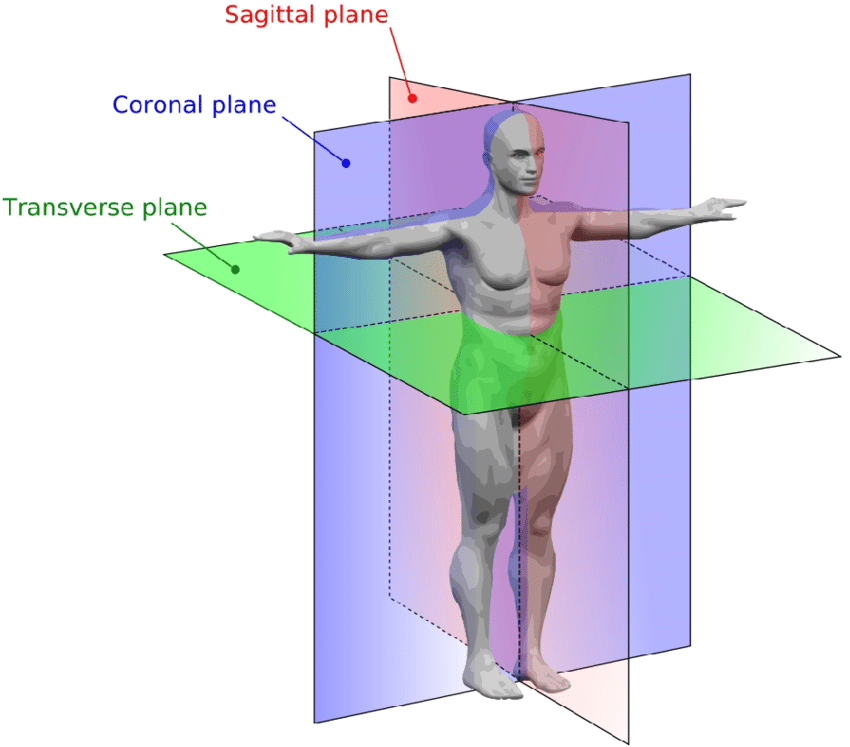
3 MOST COMMON BODY PLANES
lie at right angles to each other
sagittal plane
frontal (coronal) plane
transverse (horizontal) plane
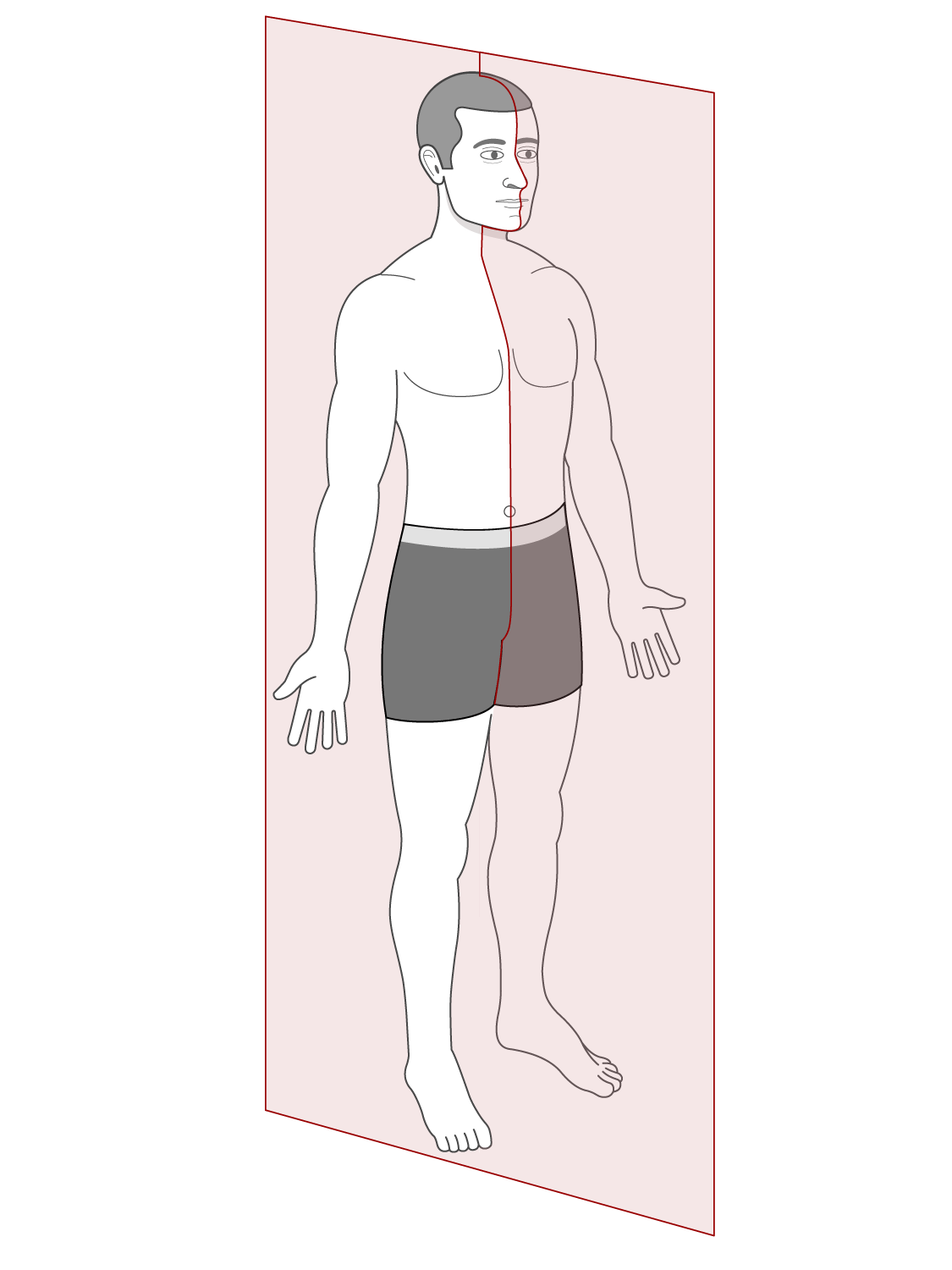
SAGITTAL PLANE
divides body into right and left parts
produces a sagittal section
Midsagittal (median) plane
lies on midline
Parasagittal plane
Not on midline
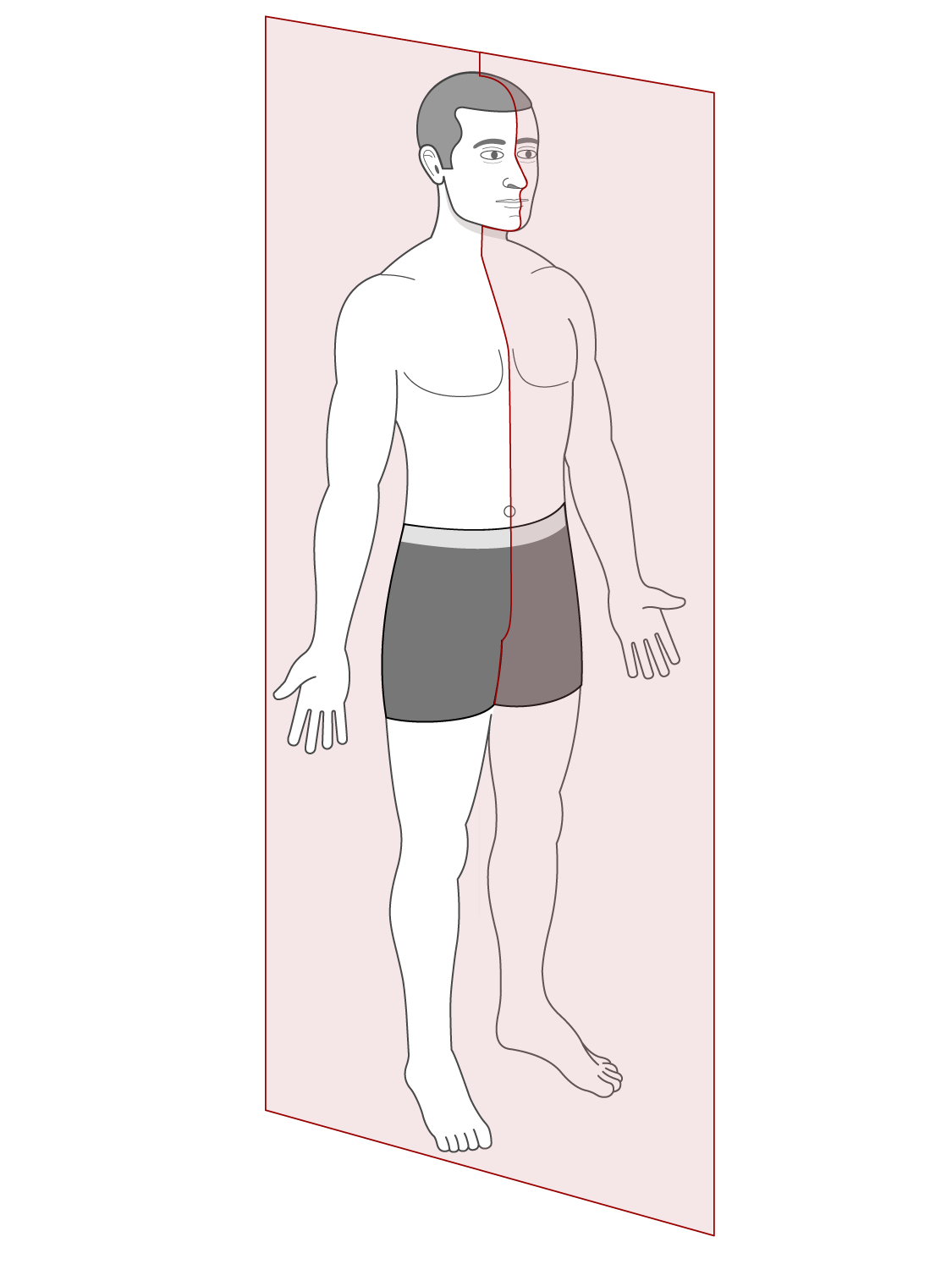
FRONTAL (coronal) PLANE
divides body into anterior and posterior parts
produces a frontal (coronal) section
TRANSVERSE (horizontal) PLANE
divides body into superior and inferior parts
produces a cross section
OBLIQUE SECTION
result of cuts at angle other than 90 degrees to vertical plane
If a person had a toe amputated, the surgeon would make a ______ cut to amputate the toe.
transverse
TWO SETS OF INTERNAL BODY CAVATIES
cavities are separate from each other so they don’t mix
dorsal body cavity (cranial - head & vertebral - spine)
ventral body cavity ( thoracic - chest & abdominopelvic - abdominal/ pelvic)
THORACIC CAVITY SUBDIVISIONS
pleural cavities
each surrounds a lung
mediastinum
contains pericardial cavity (heart)
surrounds thoracic organs
pericardial cavity
encloses heart
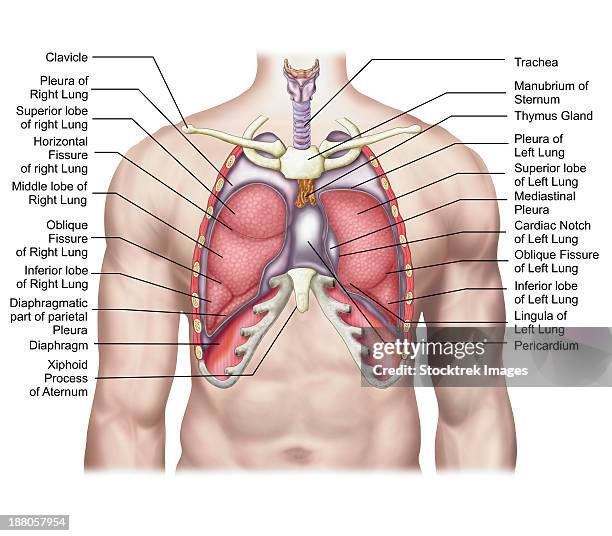
ABDOMINOPELVIC CAVITY SUBDIVISIONS
abdominal cavity
contain stomach, intestines, spleen, and liver
pelvic cavity
contains urinary bladder, reproductive organs, and rectum
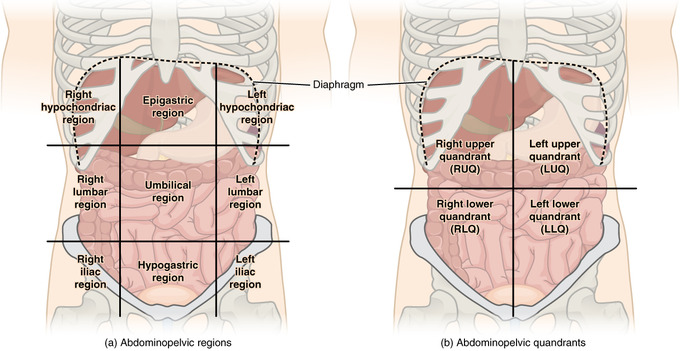
SEROUS MEMBRANE/ SEROSA
thin, double- layered membranes
layers separated by slit- like cavity filled with serous fluid
fluid secreted by both layers of the membrane
jelly like substance so organs don’t rub together and don’t hurt
PARIETAL SEROSA
lines internal body cavity walls
on the outer side layer
VISCERAL SEROSA
covers internal organs (viscera)
closer to organ
PERICARDIUM
heart
PLEURAE
lungs
PERITONEUM
abdominopelvic cavity
BODY CAVATIES EXPOSED TO ENVIRONMENT
oral and digestive cavities
nasal cavities
orbital cavities
middle ear cavities